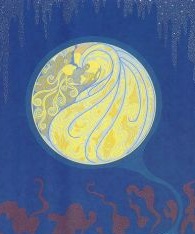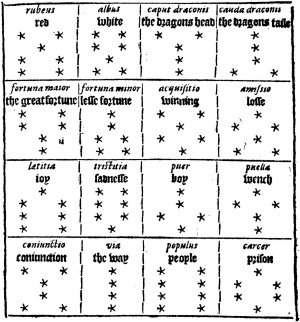Elven World Healing Arts Community
Sacred Geometry
Sacred Geometry - A group to discuss Sacred Geometry here on Earth and in the Universe.
Introduction to Astrological Geomancy
 |
Astrological geomancy is an ancient method of divination. The word geomancy means earth divination and is believed to have come from the use of sand to generate the geomantic figures, the basis of prediction in geomancy. This also accounts for its Arabic name, ilm al-raml, literally the science or wisdom of the sand.
In the modern era the ancient art of divinatory geomancy has been confused with Chinese feng shui which is not a method of divination, but a science of spatial arrangement, architecture and landscaping. Divinatory geomancy has also had its name appropriated by the modern New Age study of ley lines and earth "energies" which are also not techniques of divination.
Contemporary practitioners of the traditional Western art of geomancy have taken to referring to it as divinatory or astrological geomancy to differentiate it from these more modern uses of the term. Astrological geomancy is a particularly appropriate term as much of the divinatory methodology used in geomancy comes from traditional astrology.
The origins of geomancy are shrouded in mystery, but the first manuscripts describing the practice appear in the 9th century AD in the advanced Islamic civilization of the Middle East. From there it spread to Europe in the 11th and 12th centuries as part of the reception of many arts and sciences, including the occult arts of astrology, alchemy and magic by the rapidly civilizing West. Known in Arabic as ilm al-raml, literally the science or wisdom of the sand, geomancy became quite popular as a divinatory technique because of its ease of learning and use. Here is an interesting article in pdf form by the Dutch academic Wim van Binsbergen on the Astrological Origin of Islamic Geomancy. Because of its close connection to astrology, geomancy has been called "the Daughter of Astrology" and known as terrestial astrology.
The 16 Geomantic Figures
 16 Geomantic Figures |
The basis of geomancy is the 16 geomantic figures, composed of 4 rows of either one or two points. Thus geomancy is similar to the Chinese divinatory system of the I Ching with its 64 hexagrams as well as Ifa divination with its 256 odu or parts, as each of these is a a binary system based on the powers of 2. In geomancy each figure has its own distinct meaning. The combinations and interactions of the geomantic figures for a particular question allows the geomancer to see the underlying pattern of a particular situation and thus to see the past and present as well as predict the future.
Each of the figures has a name and its own distinct personality. The combinations of the figures and their interactions are like a mirror reflecting the events or question that the geomancer has been asked about.
Here are the 16 Geomantic figures and their Latin and English names and their planetary rulerships.
- Carcer, Prison, Saturn
- Tristitia, Sadness, Saturn
- Acquisitio, Gain, Jupiter
- Laetitia, Joy, Jupiter
- Puer, Boy, Mars
- Rubeus, Red, Mars
- Fortuna Major, Greater Fortune, Sun
- Fortuna Minor, Lesser Fortune, Sun
- Puella, Girl, Venus
- Amissio, Loss, Venus
- Conjunctio, Union, Mercury
- Albus, White, Mercury
- Via, Way, Moon
- Populus, People, Moon
Ametrine -(MHZ)
Thank you Oriel, Blessings
May 10, 2017